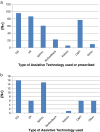Translation of evidence-based Assistive Technologies into stroke rehabilitation: users' perceptions of the barriers and opportunities
- PMID: 24620739
- PMCID: PMC4007558
- DOI: 10.1186/1472-6963-14-124
Translation of evidence-based Assistive Technologies into stroke rehabilitation: users' perceptions of the barriers and opportunities
Abstract
Background: Assistive Technologies (ATs), defined as "electrical or mechanical devices designed to help people recover movement", demonstrate clinical benefits in upper limb stroke rehabilitation; however translation into clinical practice is poor. Uptake is dependent on a complex relationship between all stakeholders. Our aim was to understand patients', carers' (P&Cs) and healthcare professionals' (HCPs) experience and views of upper limb rehabilitation and ATs, to identify barriers and opportunities critical to the effective translation of ATs into clinical practice. This work was conducted in the UK, which has a state funded healthcare system, but the findings have relevance to all healthcare systems.
Methods: Two structurally comparable questionnaires, one for P&Cs and one for HCPs, were designed, piloted and completed anonymously. Wide distribution of the questionnaires provided data from HCPs with experience of stroke rehabilitation and P&Cs who had experience of stroke. Questionnaires were designed based on themes identified from four focus groups held with HCPs and P&Cs and piloted with a sample of HCPs (N = 24) and P&Cs (N = 8). Eight of whom (four HCPs and four P&Cs) had been involved in the development.
Results: 292 HCPs and 123 P&Cs questionnaires were analysed. 120 (41%) of HCP and 79 (64%) of P&C respondents had never used ATs. Most views were common to both groups, citing lack of information and access to ATs as the main reasons for not using them. Both HCPs (N = 53 [34%]) and P&C (N = 21 [47%]) cited Functional Electrical Stimulation (FES) as the most frequently used AT. Research evidence was rated by HCPs as the most important factor in the design of an ideal technology, yet ATs they used or prescribed were not supported by research evidence. P&Cs rated ease of set-up and comfort more highly.
Conclusion: Key barriers to translation of ATs into clinical practice are lack of knowledge, education, awareness and access. Perceptions about arm rehabilitation post-stroke are similar between HCPs and P&Cs. Based on our findings, improvements in AT design, pragmatic clinical evaluation, better knowledge and awareness and improvement in provision of services will contribute to better and cost-effective upper limb stroke rehabilitation.
Figures



References
Publication types
MeSH terms
Grants and funding
LinkOut - more resources
Full Text Sources
Other Literature Sources
Medical
Miscellaneous

